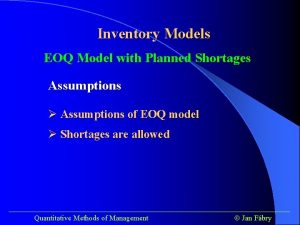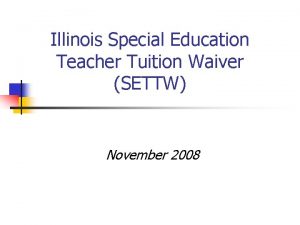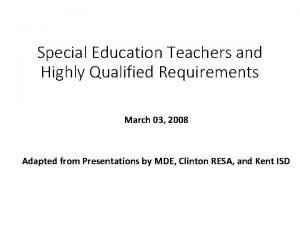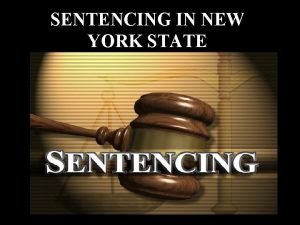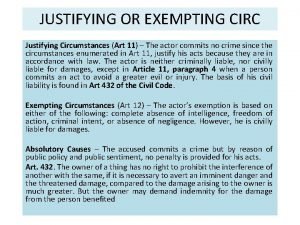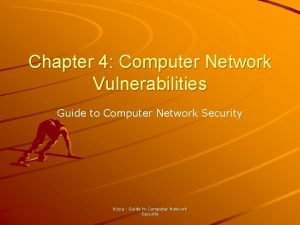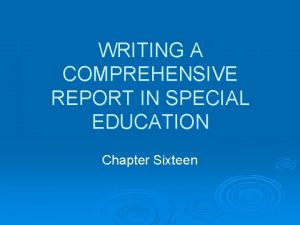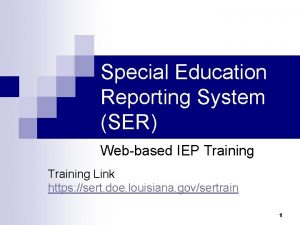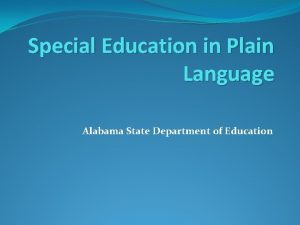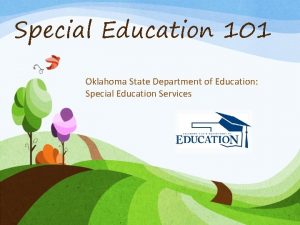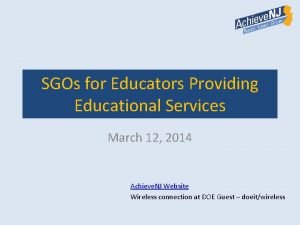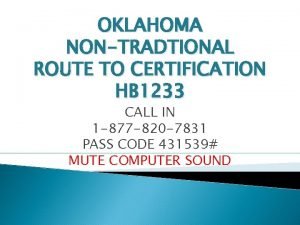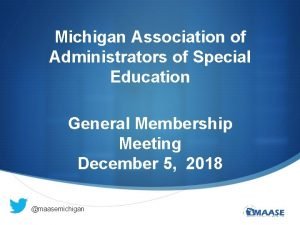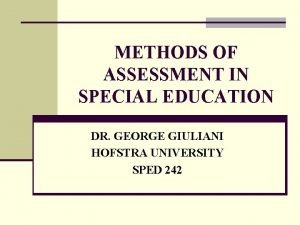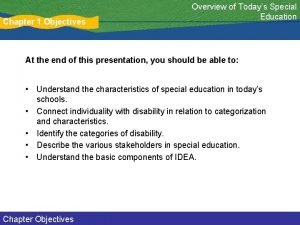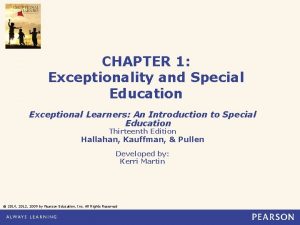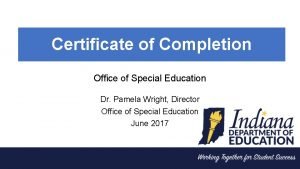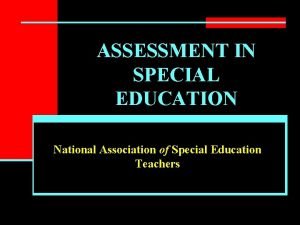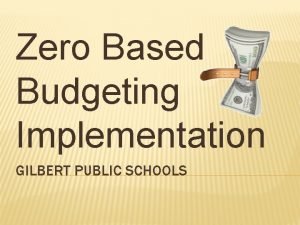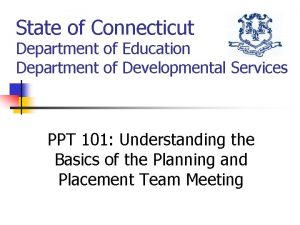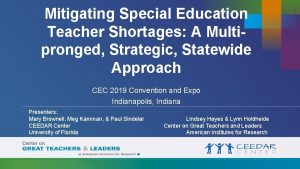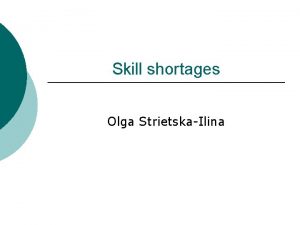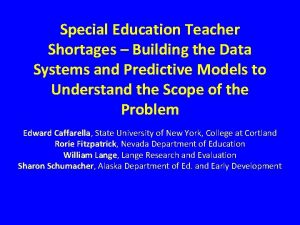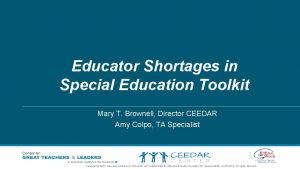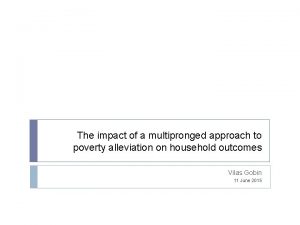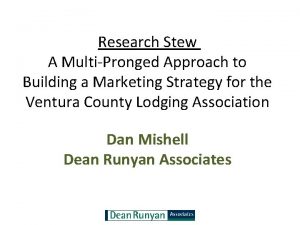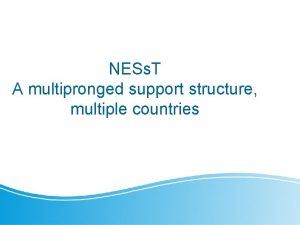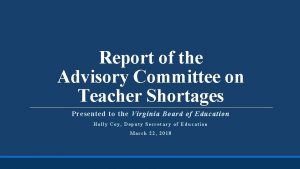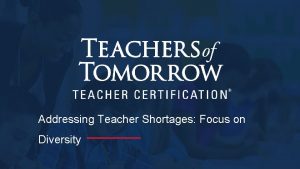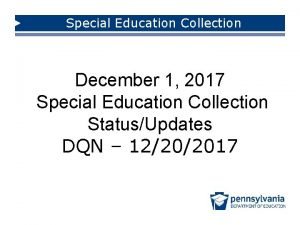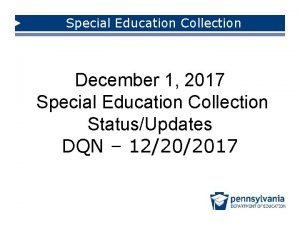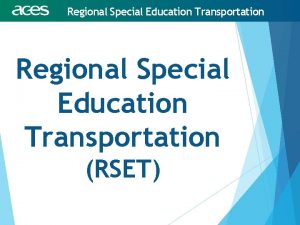Mitigating Special Education Teacher Shortages A Multipronged Strategic


































- Slides: 34

Mitigating Special Education Teacher Shortages: A Multipronged, Strategic, Statewide Approach Teacher Education Division Council for Exceptional Children 11/8/2018

PRESENTERS & MODERATOR Moderator: Dave Guardino, OSEP Presenters: Mary Brownell, UF Lynn Holdheide, AIR Meg Kamman, UF Jonte Myers, UF

TODAY • Background and research on shortages • Introduce Shortage Toolkit • Gain your feedback

EDUCATOR EFFECTIVENESS Accountability systems don’t get schools out of needs improvement status, EDUCATORs do!

EQUITABLE ACCESS TO EFFECTIVE TEACHERS 5

SETs with a certificate from a preparation program or 30 hours of credit completion have higher student valueadded scores in reading and math (Feng & Sass, 2013). WHAT MATTERS? Preparation Fully prepared special education teachers demonstrate more effective instruction than those teachers with little preparation (Nougaret, Scruggs, & Mastropieri, 2005) Experience has been linked to the effectiveness of SETs and early childhood teachers (Croninger, King, Rathbun, & Nishio, 2007; Feng & Sass, 2013). Experience Having experienced and effective peers as colleagues influences the effectiveness of teacher candidates and the effectiveness of other peers (Ronfeldt, Loeb, & Wyckoff, 2013; Sin, Loeb, & Grissom, 2017).

SHORTAGES

STATE RESPONSES TO SHORTAGES Nobo dy ris es to low expec tation s! • Oklahoma and California have issued more emergency certificates • Arizona, Illinois, and Minnesota have lowered the standards • Arizona gave local school administrators the power to determine teacher certification • New York has allowed charter schools to certify their own teachers with less rigorous preparation West, J. (2018). Calling All Teachers, Flexing your Advocacy Muscles to Address Teacher Shortages. MSLD Rethinking Behavior

QUIZ – YOU KNOW THIS! üShortages in special education are…. pervasive or rare üSchools have many or few choices üThe students most impacted are advantaged or disadvantaged 9

SHORTAGES OF SPECIAL EDUCATION TEACHERS In a small group answer the following questions • What are the implications of shortages on the field of special education and for students with disabilities? • If you were only able to select one strategy to fix shortages in special education, what would it be?

WHAT SHOULD WE DO?

NO EASY SOLUTION Select/Hire Me

EDUCATOR TALENT MANAGEMENT Framework that: ü Addresses the career continuum ü Considers unique contexts ü Clarifies partner roles Educator Talent Management Framework: Center on Great Teachers and Leaders

Everyone takes a piece of the pie What is my role? 14 Federal Education Agency State Education Agency Educator Preparation Programs Local Education Agency

SHORTAGE TOOLKIT Phase I: Short-Term Strategies Phase II Multi-pronged, long -term systemic Strategies

PHASE I: SHORT TERM STRATEGIES Real-time Support for Immediate “Pains” 1. Alternative Preparation Programs 2. Mentoring and Induction 3. Professional Learning 4. Micro-credentials

TERNATIVE ROUTES – QUALITY FEATURES • Meaningful collaboration between institutes of higher education (IHEs) and districts • Adequate program length with cohesive learning opportunities • Adequate supervision from IHE supervising teachers and building-based mentors Rosenberg & Sindelar, 2005 #1

ALTERNATIVE ROUTES- MODELS Typically meet Assurance 14 requirements

INTERNSHIP MODEL – KEY FEATURES • Bachelor’s degree in any field • Coursework/ PD • Mentoring/Induction • Allows candidates to be the teacher of record • Fulfill state testing requirements • Duration generally up to 3 years

RESIDENCY MODEL- KEY FEATURES • Requires Bachelor’s degree • Coursework/ PD • Mentoring/Induction • Candidates are not initially allowed serve as the teacher of record* • Fulfill state testing requirements • Duration generally up to 3 years *May assume teaching role after first year in some cases

MENTORING AND INDUCTION – QUALITY FEATURES • Rigorous mentor selection • Mentor training and ongoing professional development • Time for mentee/mentor interaction • Multi-year • Focus on improving instruction, data driven discussions • Ongoing beginning teacher professional development • Administrative support • Process for communication between stakeholders #2

PRACTICE-BASED OPPORTUNITIES & PROFESSIONAL LEARNING- QUALITY FEATURES #3

MICRO-CREDENTIALS- QUALITY FEATURES • Focus on skills related to teaching students with disabilities • Provide opportunities for educators to learn and demonstrate discrete skills • Recognize educators for mastery of skills with shareable micro-badges #4

COMMONALITIES & STRATEGIES Commonalities Design Strategies: ü Partnerships • High-Leverage Practices ü Mentor Selection & Training ü Pedagogy – Instructional Strategies ü Practice-Based Opportunities/Professional Learning • Practice-Based Opportunities

DECISION-GUIDE & HOW TO GUIDE Role What can the school leadership do? What can the district do? What can the Educator Preparation Program do? What can the SEA do? Steps Exemplars

PHASE II: MULTI-PRONGED, LONG-TERM SYSTEMIC STRATEGIES

EXISTING EDUCATOR SHORTAGE RESOURCES https: //www. ecs. org/wp-content/uploads/Teacher-Shortages-What-We-Know. pdf https: //teachershortage. solutiontoolkit. org/

PHASE II: COMPREHENSIVE, SYSTEMATIC APPROACH ü Identification of strategies per gaps across the career continuum ü Smorgasbord/diversification of the portfolio ü Targeted strategy selection per unique contexts

PHASE II: STRATEGY SELECTION FACILITATION PROCESS

GAP ANALYSIS Development of Gaps • Is it a production problem? 73% 74% (Attract) 59% 41% St u bl den ic t. P Sc o h H oo pul Te ig at h l ac E io S P n Te her ost cho nro llm se ol ac Pr c Te her epa ond Gra ent ra du Pr ac ep tio ary he at E n a r. P nr ion ra P r r o ti Ed e og llm uc par on Pr ram en at at og t io io A n n Pr ram ppli Ba ch og Ad ed r el or am mit s D En t ro ed e Pa llm ss gre e en st at Co nf t e lic e en rre d su Su re bm te Pa i Ce st Pa ttin rti g cip ss Ap rtifi i e Pa ati ng pl I n ic d n rti cip g in itia atio l D n at in istr Scre s gi ict e n n Sc Int ing er ho vi ol In ew s te rv ie w Ac Sel s ce ect 3 pte ed Ye d Of ar fe R 5 e te r Ye n ar t Re ion te nt io n 21% 23% 20% 19% 21% 18% 16% Pu • Is it a distribution/equitable access 35% 34% 37% 26% 26% and Support)? 65% 66% 63% 52% 50% 51% 49% 48% • Is it an attrition problem? (Prepare problem (Attract, Prepare, and 84% 82% 80% 81% 79% 77% Center on Great Teachers and Leaders Data Tool to Establish an Diverse, Effective Educator Workforce

MULTIPLE OPTIONS BASED UPON NEEDS Five Year Preparation Programs with Practice. Based Opportunities Incentives and Loan Forgiveness National Board Certified Teachers Grow Your Own Programs Sign-on Bonus Paraprofessional Step Up Programs Competitive Compensation Teacher Leadership Quality Professional Learning Systems

TOOLKIT FEEDBACK • Phase I • What other short-term strategies should be included/considered in supporting less-than prepared teachers? • What are some innovative ways that EPPs can or have engaged in short-term solutions? • Phase II • How can the tool be used to establish regional partnerships to address shortages per unique contexts? • What role can or have EPPs play(ed) in creating a multi-pronged, long-term approach to addressing shortages? Are there policies/requirements that prevent innovative solutions? What innovative solutions are already underway?

QUESTIONS 33

DISCLAIMER This content was produced under U. S. Department of Education, Office of Special Education Programs, Award No. H 325 A 170003. David Guardino serves as the project officer. The views expressed herein do not necessarily represent the positions or polices of the U. S. Department of Education. No official endorsement by the U. S. Department of Education of any product, commodity, service, or enterprise mentioned in this website is intended or should be inferred. 34
 Define multipronged
Define multipronged Inventory model with planned shortages
Inventory model with planned shortages Supply chain shortages are
Supply chain shortages are Scarcity definition economics
Scarcity definition economics Special education teacher tuition waiver
Special education teacher tuition waiver Highly qualified special education teacher
Highly qualified special education teacher Examples of mitigating factors
Examples of mitigating factors Response
Response Justifying circumstances article 11
Justifying circumstances article 11 Chapter 4 vulnerability assessment and mitigating attacks
Chapter 4 vulnerability assessment and mitigating attacks Equivalent record form sample
Equivalent record form sample Good morning students
Good morning students Strategic fit vs strategic intent
Strategic fit vs strategic intent Puppy dog ploy
Puppy dog ploy Strategic competitiveness
Strategic competitiveness Cultural aspects of strategy choice
Cultural aspects of strategy choice Writing a comprehensive report in special education
Writing a comprehensive report in special education Https//serp.doe.louisiana.gov/ser
Https//serp.doe.louisiana.gov/ser Special education in plain language
Special education in plain language Sbcselpa
Sbcselpa Special education 101
Special education 101 Sgo examples for special education
Sgo examples for special education Oklahoma special education boot camp
Oklahoma special education boot camp National council for special education
National council for special education Maase jobs
Maase jobs Assessment process in special education
Assessment process in special education Special education handbook oklahoma
Special education handbook oklahoma Objectives of special education
Objectives of special education Exceptional learners: an introduction to special education
Exceptional learners: an introduction to special education Coc certificate of completion
Coc certificate of completion Special education free apps
Special education free apps What is assessment in education
What is assessment in education Gilbert public schools salary
Gilbert public schools salary Iep components special education
Iep components special education Special education counselor
Special education counselor

